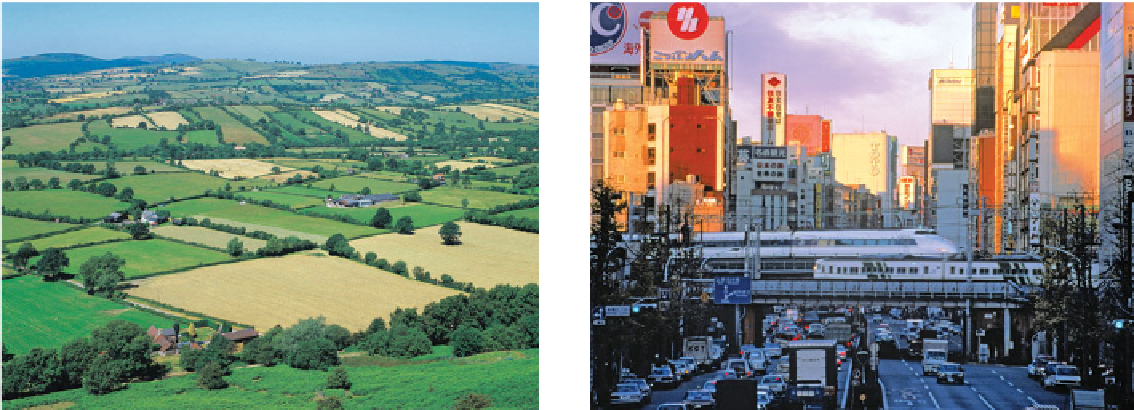Geoscience Reference
In-Depth Information
(a)
(b)
Figure 5.12 Urban vs. rural landscapes.
The different characteristics of city and rural surfaces can significantly influence temperature.
(a) Rural surfaces such as this Scottish landscape are cooler because less radiation strikes the ground due to tree cover, and more water
is found in soil and on vegetation surfaces. (b) Urban surfaces, in contrast, receive more direct radiation and absorb more radiation. This
image shows a portion of the cityscape in Tokyo, Japan.
4.
Water stores a large amount of thermal energy and thus
moderates the air temperature above it on a seasonal
basis. In contrast, landmasses store relatively little ther-
mal energy, which causes a greater annual range of air
temperature.
Urban environments tend to be warmer than rural areas for
several reasons. One of the most important reasons for this ef-
fect is that urban surfaces consist of metal, glass, asphalt, and
concrete, whereas rural areas are covered with soil in which for-
est and grass grow. As a result, urban surfaces tend to be darker
than rural surfaces, which leads to greater net radiation in cities
because albedo is lower. In the context of this higher net radia-
tion, up to 70% of net radiation in cities is converted to sensible
heat, much more so than in the countryside. Urban surfaces also
conduct more energy than rural soils and are thus warmer. This
effect is magnified by the fact that forest canopies in rural areas
shade the ground beneath them, keeping them relatively cool. In
urban environments, on the other hand, solar radiation strikes the
surface directly and is absorbed, later to be released as warming
longwave radiation. This re-radiation tends to be trapped for lon-
ger periods of time in cities, further warming them, because the
irregular geometry of city buildings limits wind speed by about
20% to 30% over the course of the year. This decreased flow of
air reduces the loss of heat that would otherwise occur.
Another reason why cities are warmer than rural places is re-
lated to the way water is stored and moves in the two areas. In
rural areas where soils cover the landscape, rainfall and snowmelt
gradually soak into the ground. As described earlier, water has a
modifying effect on temperature, which results in soils being cool-
er than urban surfaces. The presence of water in rural soils also
reduces the conductivity of those surfaces, keeping them relatively
cool. In contrast, urban surfaces tend to be sealed because they are
paved or covered with buildings. The effect of this change in land
cover on the way water is stored and moves is significant because
water does not absorb into the ground in cities in the same way as
it does in the countryside. Instead, precipitation rapidly runs across
these surfaces and into storm drains that carry it away. Thus, the
modifying effect that water has on the temperature of soils in rural
areas does not exist in cities, causing them to be warmer.
Yet another reason cities are warmer than rural areas is the
impact that human activities have on urban environments. In hot
summer months, the production of electricity to cool homes and
5.
Distinct geographic patterns occur with respect to air
temperature on Earth. Large landmasses and high lati-
tudes typically exhibit a wide range in temperature. In
contrast, locations at low latitudes and near large water
bodies have a very narrow temperature range.
Human Interactions:
Urban Heat Islands
In addition to the natural variables that influence air
temperature, such as latitude, maritime effect, and topography,
another important factor is the human influence as it relates to
large cities. Urban centers are growing all around the world in
response to increased human population and inward migration.
Between 1990 and 2010, for example, the collective popula-
tion in the world's cities grew from two to three billion, so that
now approximately half of the people in the world live in cit-
ies. As cities continue expanding, more of the natural landscape
is transformed into new buildings, homes, and parking lots
(Figure 5.12). In this process, vegetation is removed and soils
are covered by pavement or other structures. This human-in-
duced change in land cover can cause a measurable temperature
increase in and around a city through a variety of ways, resulting
in a distinct geographic feature known as an
urban heat island
where temperatures may be as much as 3°C to 4°C (6°F to 8°F)
warmer (or more) than the surrounding countryside.
Urban heat island
The relatively warm temperatures associ-
ated with cities that occur because paved surfaces and urban
structures absorb and release radiation differently from the


